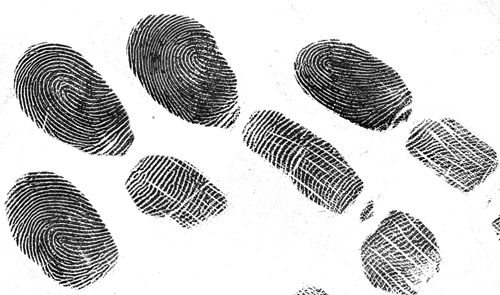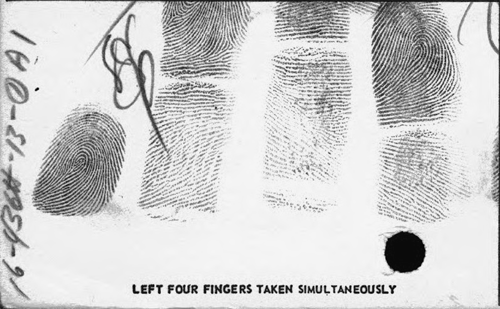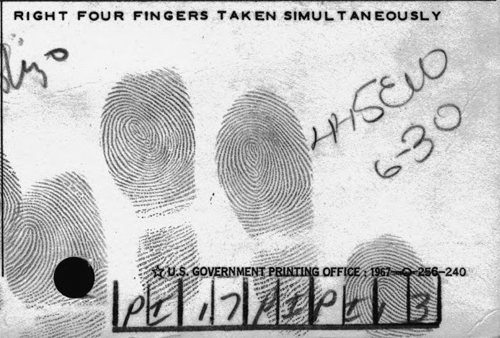
Issues
This document is a brief overview of slap fingerprinting, including a summary of the characteristics of those operational slap images that are potentially difficult to segment.
Slap Fingerprint Overview
Slap fingerprints, or "simultaneous plain impressions," are simply multiple flat fingerprints captured at the same time. They have been collected on paper fingerprint cards for decades, when their primary purpose was to allow sequence checking: verification that the rolled fingerprints on the card were in the correct order.
The examples below show slap fingerprints from paper and livescan sources.
Slap fingerprints have received increasing attention for possible use in large-scale fingerprint identification systems for non-criminal background checks, as a possible compromise between the use of rolled fingerprints and single finger flat fingerprints.
Rolled fingerprints
Sets of rolled fingerprints have been used for identification for decades, and provide a very accurate means of identification. However, operators must be well trained to collect good quality rolled fingerprints; the process is slow and requires physical manipulation of each of the subject's fingers by the operator. The use of slaps offers operational improvements over the use of rolled fingerprints, since collecting slap fingerprints is a rapid process that does not require the same degree of operator training and "manhandling" of the subject. However, each slap fingerprint averages less than half of the area of a good-quality rolled fingerprint: slaps therefore have fewer minutiae, and are harder to classify.
Single-finger flat fingerprints
Single-finger flats are frequently used for verification systems or small to medium-sized identification systems. Several studies, including the recent FpVTE 2003, have shown that identification accuracy increases substantially as the number of fingers used increases, indicating that at least four fingers should be used for large-scale identification systems. Although single-finger scanners can be used to collect multiple fingers, sequence errors (in which fingerprints are taken out of order) are expected to be a substantial source of error when multiple fingers are taken on single-finger scanners. For these reasons, the use of slaps offers improvements in performance accuracy and efficiency over the use of single-finger flats, especially since four fingerprints can be collected in each image. Operationally, however, slap fingerprint scanners are larger and more expensive than single-finger fingerprint scanners.
A number of issues must be addressed in order to use slap fingerprints in an operational system. Key among these is the problem of segmentation error: segmentation can introduce errors, which could result in failures to enroll (FTE), or, if undetected, the enrolling of fingerprints into the database in the wrong order.
Problem Cases
Most livescan slap fingerprints are straightforward to segment. However, some livescan slaps, and a larger proportion of slaps from paper sources, are difficult to segment accurately. This document briefly describes some of the characteristics of hard-to-segment images.
Please note that the following examples are unusual cases; while they do occur, they are not typical of most images used in SlapSeg04.
Rotation
Most slap images (except possibly those from large-platen livescans) are rotated. The amount of rotation varies, but averages 20-25 degrees. Few images are rotated more than 45 degrees. Fingers from the left hand are usually rotated clockwise, and those from the right hand are usually rotated counterclockwise.
When slaps are rotated more than usual, it may be more difficult to find the pads of all fingers, such as the index finger in this example.
|
 |
Cropped Fingers
Fingerprints frequently overlap the edges of slap images. Cropped fingers may affect the quality of the resulting fingerprints and/or the accuracy of segmentation.
|
 |
Missing Fingers
Missing fingers are rare, but do occur.
|
 |
Compressed Fingers
Fingers are occasionally pressed together unnaturally to force them on the platen, or into the box on the fingerprint card.
|
 |
Paper Background Noise
Images from paper cards include the paper texture, unlike livescan images, which generally have pure white backgrounds.
|
 |
Latent fingerprints
Most slap livescan devices employ a background removal algorithm that results in a pure white background. On occasion, this background removal is not successful, and the backgrounds contain latent fingerprint detail, so the feature extraction process will find minutiae in these backgrounds.
|
 |
Haloing around fingers
Some livescan images have gray haloes around the fingers, apparently due to temperature or moisture.
|
 |
Handwritten and printed text, lines, punch holes, and marks
Paper fingerprint cards have preprinted text and lines. In addition, handwritten and printed text may be added to the card, and holes may be punched in it.
|
 |
Thumb overlapping edge of image
In some cases, fingerprints in the neighboring boxes on a paper fingerprint card may overlap the edge of the slap.
|
 |












